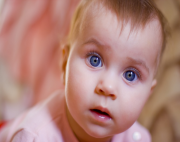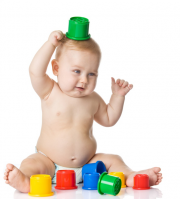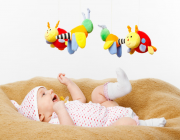Every parent wants the best for their child, and that includes good vision and good visual skills like tracking and moving the eyes as a team. There are a lot of little things parents can do to help their child with this process, and have fun with their baby, too.
Most of us think of vision as an inherent, natural thing that just happens, but in truth, using vision is a skill that can be learned and improved. Infants learn about everything in their world, using their eyes, ears, nose, mouth and hands all the time. They are actively learning every waking moment, and possibly even while they sleep; some experts in infant development believe an infant’s brain is busily processing and sorting all their experiences of the previous day as they sleep and dream.
Parents can help vision development by watching for signs of eye and vision problems, scheduling their baby’s first vision exam early in life, and engaging in age-appropriate activities that encourage its process. Most of these are not only vision-helpful but are fun for both infants and parents.
Some experts recommend an eye exam for infants as early as six months of age, while others advise that the first exam should be done before the age of three. All are unanimous, however, in advising that first checkup early. It may be surprising to new parents just how much information can be gathered even from an infant, without the need for any language skills at all. An infant’s vision exam should include eye health, including normal neurological connections such as colour vision, an assessment the level of clarity, and the presence of a refractive error (nearsightedness, farsightedness and astigmatism) in one or both eyes. The pediatric eyecare specialist will also check for strabismus and amblyopia.
Because they are always observing their baby, parents play a key role not only in catching eye and vision problems early, but in helping their child develop good vision skills that will be important lifelong. Parents should know, however, that all infants don’t learn at the same rate and any list of things to watch for is a guideline only, not a hard-and-fast rule.
Most parents do find that knowing what is normal and expected in terms of developmental milestones is very helpful as they watch their child grow and learn.
Infancy
According to the College of Optometrists in Vision Development (COVD), a group of optometrists which is devoted to in-depth testing and functional vision problems, parents can do a lot to help their newborns develop great vision skills and good physical coordination in later life as well. The information in these guidelines comes from COVD and other sources.
Newborn infants can’t see very well because their vision isn’t fully developed; their eyes don’t track accurately or work together as a team yet, but they do see objects or faces at short distances, between 8 to 10 inches or so. During this period, parents should not be concerned if they see one eye turning inward or outward briefly but if it seems to turn in or out all the time, an evaluation by an eyecare practitioner will be necessary, and the sooner the better.
By eight weeks, infants should begin to focus on specific objects and begin to look at faces, in particular those of their parents. Hand-eye coordination begins as the baby begins to follow moving targets and to reach for them. Along with these skills, their vision has become more clear and they can begin to focus by the age of about three months.
Here’s a general list of things to look for and how to help this learning process along.
- Provide moving targets (especially faces) up, down, side-to-side and closer and farther away so baby learns to follow them with his or her eyes.
- Make noises to the sides so baby turns towards them.
- Bounce the baby gently on the bed on hands and knees with support to help begin to learn about balancing.
- Provide lots of toys to touch, grasp, feel, listen to and search for with eyes and ears.
- Use a nightlight or other dim lamp in the baby’s room.
- Keep reach-and-touch toys within focus for the baby, about 8 to 10 inches.
- Talk to the baby as you walk around the room.
- Alternate right and left sides with each feeding.
One month: Baby John or Jane (Baby J) should be able to follow an object with his or her eyes and not the entire head or body.
- Hold and feed Baby J from alternating sides to promote development of both eyes.
- Change Baby J’s orientation in the crib and the crib position in the room, to change his or her view of the world.
- Hang a mobile off to the side so baby can see it through the slats of the crib.
Two Months: Baby J should be able to bring his or her hands together.
- Allow exploration with the hands.
- Provide toys of many different weights, sizes, textures and shapes.
- Place a lightweight rattle in Baby’s hands and help to shake it.
Four Months: Baby J should be able to turn his or her eyes together to focus on objects that are close by. They begin to reach for objects and have developed the ability to appreciate colours.
- Allow Baby J to help hold the nursing bottle.
- Play the “Patty-Cake” game.
- Give lots of toys or objects that Baby J can explore using his or her mouth and hands as well as vision.
- Allow Baby J to reach for objects. They will become skillful at grasping objects at this age.
Five Months: Baby J should be able to make the sounds for P, B, T, D and M.
- Play “Peek-a-Boo” to help develop visual memory.
- Move the crib mobile closer so Baby can reach it, touch it and move it.
- Tie bells on Booties so Baby J can learn about his or her body through sound as well as vision.
- Depth perception begins to develop as the eyes begin to work together for the first time.
- Colour vision also begins to develop and improve.
Six to Twelve Months; during this period, babies should begin to learn to creep and crawl.
- Provide lots of toys that can be manipulated in various ways by learning to grasp, roll, pick up, push, pull, bang, throw and squeeze.
- Play games that involve dropping and picking up objects.
- Roll balls (slowly) for Baby J to follow and stop.
- Use simple words, phrases and sentences about clothing, food, toys and the body.
- Play hide-and-seek games.
Seven months: Baby J should be able roll over independently.
- Hand-and-eye coordination begins to get more accurate and useful.
- Baby J should begin using their eyes to find things and their hands to grasp them.
Eight months: Baby J should now be able to sit up without support.
- Talk to Baby J often, about everything, so they can begin to associate experiences with words
- Place objects on a high chair tray that can be pushed off and dropped
Nine Months: Baby J should be able to creep and crawl around.
- Encourage creeping and crawling, but don’t be in too big a hurry for walking quite yet.
- Cross movement development becomes important, that is, moving the right arm and left leg together, then the left arm and right leg. Physical coordination later depends on this type of movement that develops now.
Nine Months to One Year: Baby J should be experimenting with pulling themselves up into a standing position.
- Fine motor skills are also developing, such as the ability to grasp objects using thumb and forefinger.
- Babies can now judge distance fairly well and can throw things more accurately.
- At about one year, most babies will be trying to walk; this should be encouraged, providing the baby has had lots of practice crawling first.
The first year of life is exciting and interesting for parents as well as their baby. As noted above, parents can do a lot to help their baby develop good vision and coordination skills. Eye or vision problems are rare; most babies sail through life with good vision and eye health, However, parents and other caregivers should always be alert for any of the following signs of eye or vision problems that require an urgent need for medical or vision evaluation:
- Excessive tearing, which can indicate blockage in the drainage system of the eye
- Red or crusty eyelids, which can signal an infection
- Constant turning of one eye, in or out, which can indicate a problem with control of the eye movement muscles
- Extreme light sensitivity, which can be caused by elevated pressure in the eye or an inflammatory condition.
- A white pupil, which can indicate the presence of a tumor or other cancer.
COVD recommends that all children should have a comprehensive vision examination early in life; most optometrists agree, most advising an exam by the age of three and certainly before the child enters preschool or first grade. Parents should not rely on vision screenings because they typically miss at least half of vision problems that are significant enough to interfere with learning.
Watching a new baby grow and develop is surely one of life’s most rewarding activities and parents should enjoy the entire process as their children pass each milestone.
For recommendations on vision development of children one year and older, please see the article titled “Vision Development Milestones: Age One and Up.”




